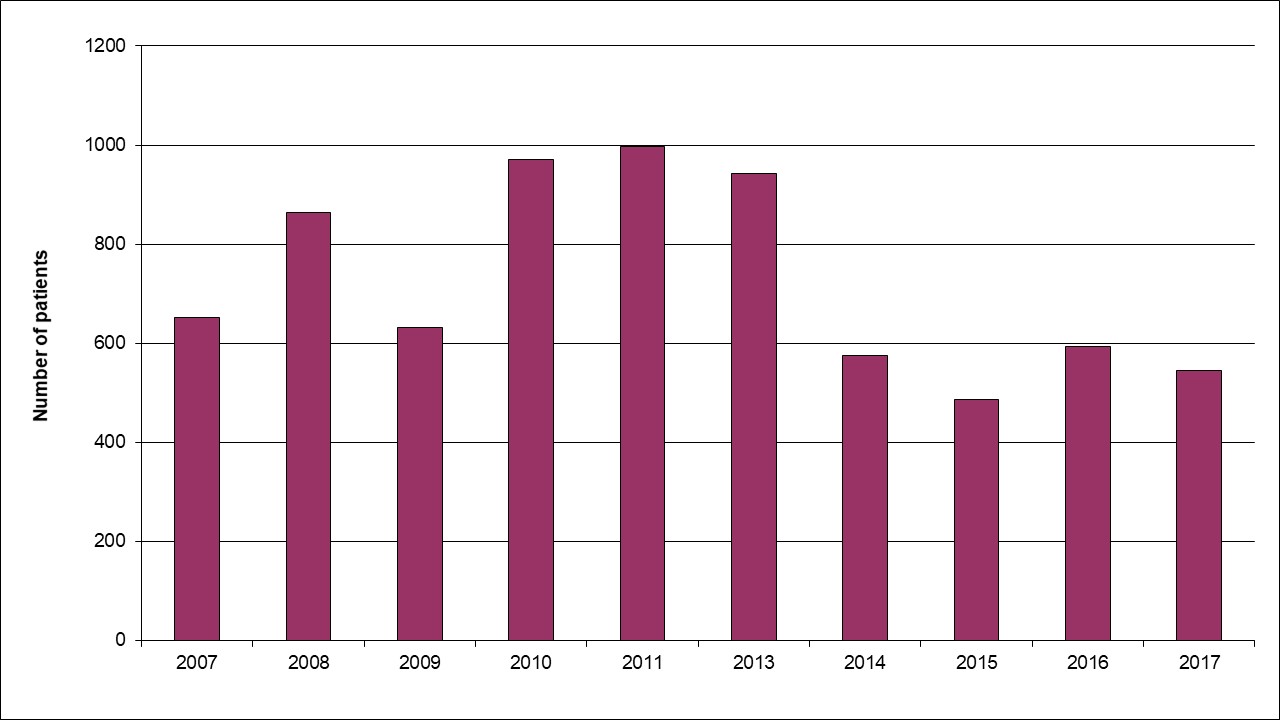Key message: The number of patients with Lyme disease is in decline
Assessment: Lyme disease or Lyme borreliosis is a multisystemic disease of the subacute and chronic flow caused by Borrelia burgdorferi bacteria. It involves primarily the skin, then the heart, joints and central nervous system. Carriers of these bacteria are ticks, rodents, deer, and others. Vectors of infection are hard ticks that transmit disease to man and domestic animals, and it occurs usually seasonally (from early spring to late autumn), mostly with people who often stay in nature. Lyme disease in the Republic of Serbia is the leading disease in the group of vector diseases, with participation in the structure of over 90%. Lyme disease is registered throughout the year, with the highest occurrence in June and July in the month when the tick population is the most numerous.
The number of patients suffering from Lyme disease ranges from about 500 (2015) to about 1,000 (2011). Although the number of infected ticks decreases, the number of patients with Lyme disease has been constant over the last several years. Several reasons contributed to this. First of all, more and more people reside in nature, and more often, they are exposed to the possibility of picking up ticks. The increasingly warmer spring and summer months lead to an increase in the number of small rodents that are bacteria carriers causing Lyme disease, and also contribute to faster bacterial multiplication. The climatic trends and density of key hosts for adult ticks are the major factors in the spread of ticks and contribute to the spatial distribution of Lyme disease. The latest data show that ticks in Europe are spreading to the north latitudes, and also to higher altitudes.
Annual reports of Institute for Public health:
- http://www.batut.org.rs/download/izvestaji/Godisnji%20izvestaj%20zarazne%20bolesti%202017.pdf
- http://www.batut.org.rs/download/izvestaji/zarazneBolestiGodisnjiIzvestaj2016.pdf
- http://www.batut.org.rs/download/izvestaji/Zarazne%20bolesti%20godisnji%20izvestaj%202015.pdf
- http://www.batut.org.rs/download/izvestaji/Izvestaj%20o%20zaraznim%20bolestima%202014.pdf
- http://www.batut.org.rs/download/influenca/2013ZarazneBolesti2.pdf
- http://www.batut.org.rs/index.php?content=387
- http://www.batut.org.rs/index.php?content=299
Picture 1: Number of patients with Lyme disease in Serbia
Indicator Name: Trend of Morbus Lyme patients in Serbia
Institution/Author: Environmental Protection Agency/Slaviša Popović
Use and interpretation:
Key question(s) which indicator helps to answer: What is the number of patients suffering from Lyme disease?
Use of indicator: To monitor trend of Morbus Lyme patients in Serbia
Scale of appropriate use urban, suburban, rural areas
Potential for aggregation: Lyme disease or Lyme borreliosis is a multisystemic disease of the subacute and chronic flow caused by Borrelia burgdorferi bacteria. It involves primarily the skin, then the heart, joints and central nervous system. Carriers of these bacteria are ticks, rodents, deer, and others. Vectors of infection are hard ticks that transmit disease to man and domestic animals, and it occurs usually seasonally (from early spring to late autumn), mostly with people who often stay in nature. Lyme disease in the Republic of Serbia is the leading disease in the group of vector diseases, with participation in the structure of over 90%.
Meaning of upward or downward trends: Lyme disease is registered throughout the year, with the highest occurrence in June and July in the month when the tick population is the most numerous.
Possible reasons for upward or downward trends: The number of patients suffering from Lyme disease ranges from about 500 (2015) to about 1000 (2011). Although the number of infected ticks decreases, the number of patients with Lyme disease has been constant over the last several years.
Implications for biodiversity management of change in the indicator: more and more people reside in nature, and more often, they are exposed to the possibility of picking up ticks. The increasingly warmer spring and summer months lead to an increase in the number of small rodents that are the bacteria carriers causing Lyme disease, and also contribute to faster bacterial multiplication. The climatic trends and density of key hosts for adult ticks are the major factors in the spread of ticks and contribute to the spatial distribution of Lyme disease. The latest data show that ticks in Europe are spreading to the north latitudes, and also to higher altitudes.
Units in which it is expressed: Number of patients
Description of source data: Institute for Public Health of Serbia “Dr. Milan Jovanović Batut”, Тhe Provincial Secretariat for Urban Planning and Environmental Protection, Institute for Biocides and Medical Ecology
Calculation procedure: Annual reports of Institute for Public health
Most effective forms of presentation:
Map and graphs
Limits to usefulness and accuracy:
Updating the indicator: Annually
Closely related indicators: Trend of population of infected ticks causing Lyme disease
